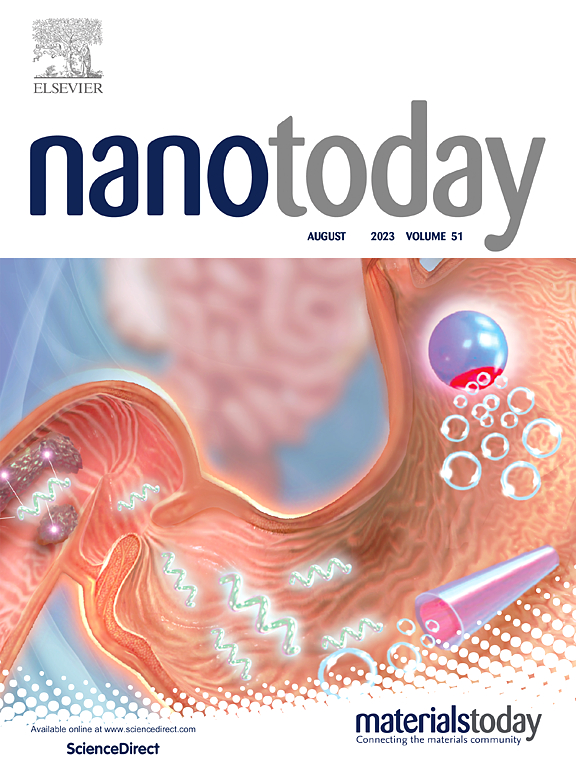Nanocatalytic antioxidation synergizes cardioprotection and antifibrosis in cardiac injury
IF 10.9
1区 材料科学
Q1 CHEMISTRY, MULTIDISCIPLINARY
引用次数: 0
Abstract
Myocardial injury and fibrosis are two important features of acute cardiac ischemia, both lead to heart failure. Clinical data indicate that targeting myocardial injury or fibrosis alone are not sufficient to improve myocardial infraction patient prognosis. Notably, reactive oxygen species (ROS) play a critical role in both myocardial injury and fibrosis, through disrupting redox homeostasis within cardiomyocytes, and mediating profibrotic signaling within fibroblasts as well. Herein, a nanocatalytic antioxidative therapeutic methodology is developed for synergistic treatment of post-ischemic cardiac injury, by using zeolitic imidazolate framework-67 nanoparticles (ZIF-67 NPs) as paradigmatic antioxidative nanocatalysts, to efficiently scavenge ROS for concurrent cardioprotection and antifibrosis. ZIF-67 NPs are capable of efficiently catalyzing hydrogen peroxide disproportionation owing to the enriched Co-N4 active sites, which can restore redox homeostasis in cardiomyocytes to inhibit apoptosis/ferroptosis. More intriguingly, the catalytic ROS-scavenging effect can further suppress redox signaling within fibroblasts to inhibit their transition to myofibroblast. In vivo results further demonstrate the significant efficacy of nanocatalytic antioxidation for cardioprotection and antifibrosis. This study provides a feasible approach for synergistic treatment of post-ischemic cardiac injury by nanocatalytic antioxidation.
纳米催化抗氧化协同心脏损伤的心脏保护和抗纤维化作用
心肌损伤和纤维化是急性心肌缺血的两个重要特征,均可导致心力衰竭。临床资料表明,仅针对心肌损伤或纤维化不足以改善心肌梗死患者的预后。值得注意的是,活性氧(ROS)通过破坏心肌细胞内的氧化还原稳态和介导成纤维细胞内的促纤维化信号,在心肌损伤和纤维化中都起着关键作用。本文提出了一种纳米催化抗氧化治疗方法,通过使用沸石咪唑酸框架-67纳米颗粒(ZIF-67 NPs)作为典型的抗氧化纳米催化剂,有效清除活性氧,同时起到心脏保护和抗纤维化的作用,从而协同治疗缺血性心脏损伤。由于富含Co-N4活性位点,ZIF-67 NPs能够有效催化过氧化氢歧化,从而恢复心肌细胞的氧化还原稳态,从而抑制细胞凋亡/铁下垂。更有趣的是,催化ros清除作用可以进一步抑制成纤维细胞内的氧化还原信号,从而抑制其向肌成纤维细胞的转变。体内实验结果进一步证明了纳米催化抗氧化对心脏保护和抗纤维化的显著功效。本研究为纳米抗氧化协同治疗缺血性心脏损伤提供了一种可行的途径。
本文章由计算机程序翻译,如有差异,请以英文原文为准。
求助全文
约1分钟内获得全文
求助全文
来源期刊

Nano Today
工程技术-材料科学:综合
CiteScore
21.50
自引率
3.40%
发文量
305
审稿时长
40 days
期刊介绍:
Nano Today is a journal dedicated to publishing influential and innovative work in the field of nanoscience and technology. It covers a wide range of subject areas including biomaterials, materials chemistry, materials science, chemistry, bioengineering, biochemistry, genetics and molecular biology, engineering, and nanotechnology. The journal considers articles that inform readers about the latest research, breakthroughs, and topical issues in these fields. It provides comprehensive coverage through a mixture of peer-reviewed articles, research news, and information on key developments. Nano Today is abstracted and indexed in Science Citation Index, Ei Compendex, Embase, Scopus, and INSPEC.
 求助内容:
求助内容: 应助结果提醒方式:
应助结果提醒方式:


